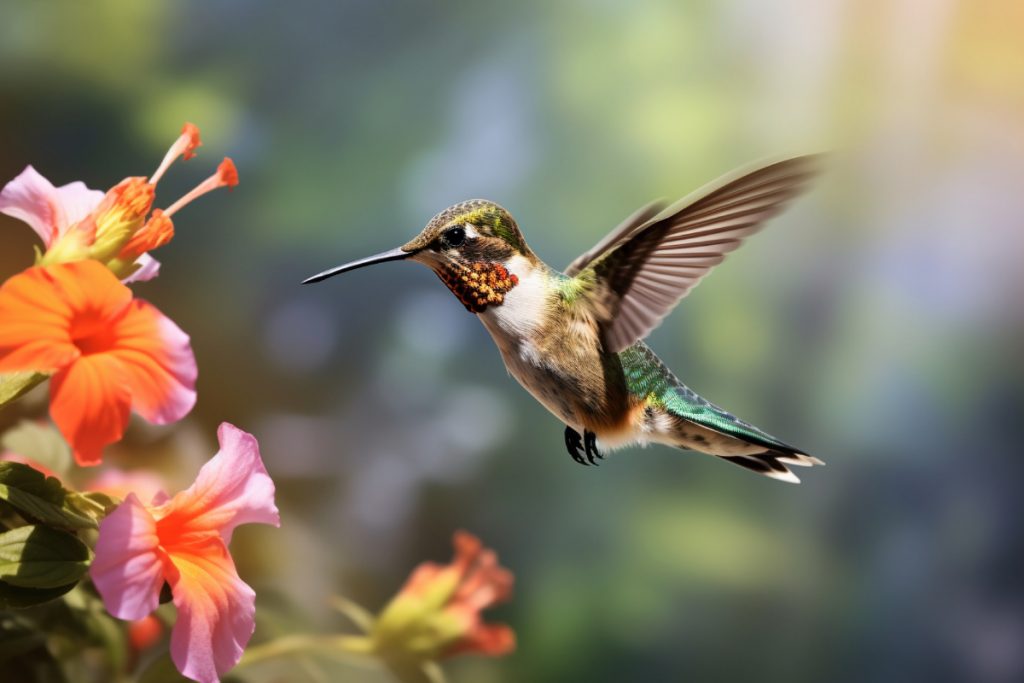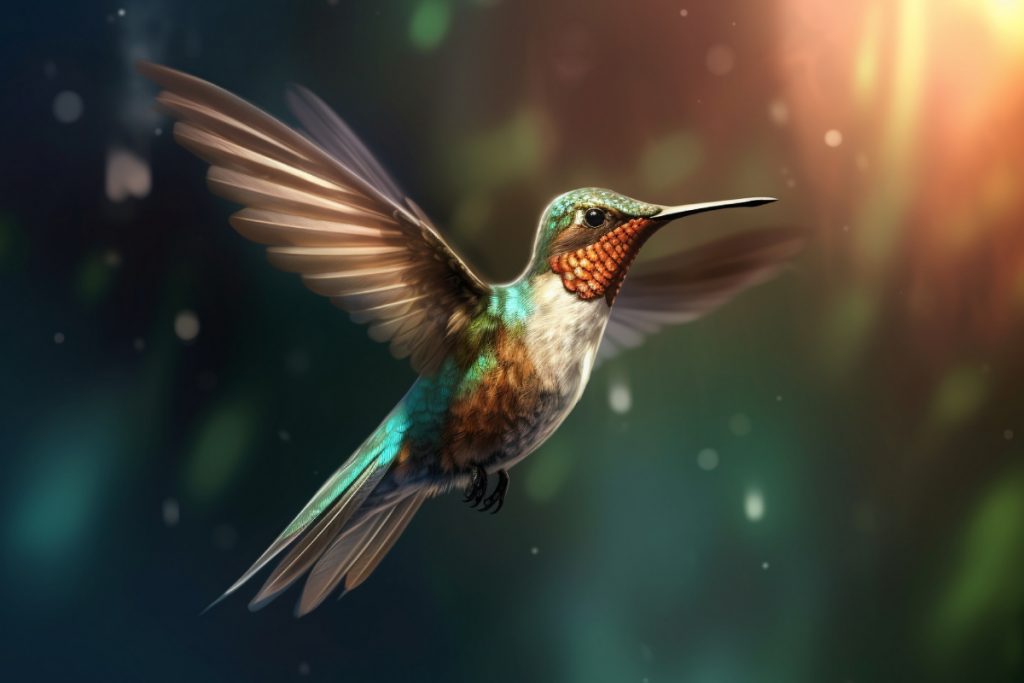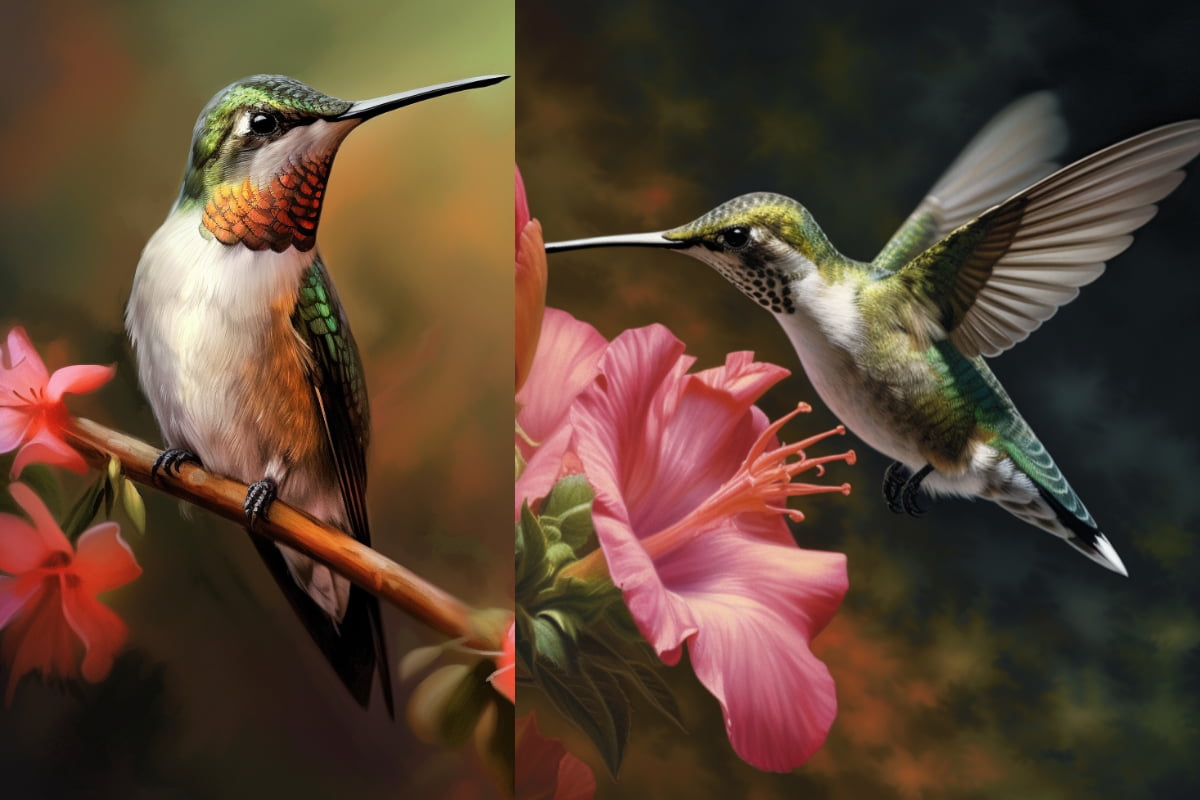Hummingbirds typically leave Michigan in late summer to early autumn, with most beginning their southward migration by late August to mid-September. Although a few may linger until the end of October.
This departure is influenced by decreasing daylight hours and diminishing food sources like nectar-rich flowers.
To support these birds before their long journey, it’s advisable for residents to keep their hummingbird feeders well-stocked during this period.
4 Key Takeaways
- The Ruby-throated Hummingbird is the most commonly found hummingbird species in Michigan. This species migrates out of Michigan every year between late August and mid-September. However, a few of them sometimes stay until the end of October.
- Migration patterns can vary, with adults typically leaving Michigan before the younger hummingbirds.
- Climate change has the potential to influence the migration timings of hummingbirds, resulting in earlier or delayed departures.
- Modern tracking methods, such as lightweight geolocators, are providing deeper insights into the precise migration routes of these birds.

In this blog post, we will discuss the migration of hummingbirds in Michigan, the migratory paths of these beautiful birds, explore the factors that compel their departure, and provide insights for keen birdwatchers in Michigan.
Related post to read about Best Hummingbird Feeders
The Species Of Hummingbirds Commonly Found In Michigan
The most common hummingbird species that grace the skies of Michigan is the Ruby-throated Hummingbird. Its brilliant red throat and rapid wing beats have made it a beloved summer visitor, creating quite the spectacle as it flits from flower to flower.

The Variation In Migration Times Between Young And Adult Hummingbirds
Interestingly, migration patterns can vary between young and adult hummingbirds in the bird world.
For Ruby-throated Hummingbirds, there’s a staggered departure. Adults, especially males, often embark on their migratory journey first, leaving the young birds behind.
This allows the juveniles, hatched during the summer months in Michigan, a bit more time to gain strength and feeding expertise. By late October, most of these fledglings have also set out on their maiden voyage to warmer climes.
The Climate Change Connection
Climate change, an undeniable global phenomenon, can indeed affect the migration patterns of many bird species, including hummingbirds. As temperatures fluctuate and seasons become less predictable, migration timings may shift.
For Michigan’s hummingbirds, warmer autumns could delay their departure. On the flip side, if food sources like nectar-rich flowers become scarce earlier due to changing climatic conditions, it might prompt an earlier exit.

The Marvel of Migration
The Journey Begins:
Duration and Distance: The journey of hummingbirds is quite remarkable. They can migrate up to 2,000 miles and travel without stopping for up to 18 hours each day. It’s amazing how these little creatures can accomplish such a big feat.
Imagine a bird weighing less than a 10p coin flying from Michigan all the way to Central America!
The Route:
Avoiding Hazards: Hummingbirds, particularly the Ruby-throated species common in Michigan, usually travel along the eastern coast of the US, skirting the Gulf of Mexico before reaching their tropical winter homes. This ensures they avoid large water masses, which pose a risk.
The Why’s and When’s of Departure
Climate’s Cue:
Temperature’s Tell: The drop in temperature in Michigan, as well as reduced daylight, signals to hummingbirds that it’s time to start their journey. This instinctual behaviour ensures their survival during the harsher months when food sources diminish.
Nectar and Nutrition:
Food Sources: In Michigan, the decline of flowering plants, and hence nectar, is a crucial determinant. Hummingbirds consume up to twice their body weight daily. As their primary food source dwindles, it’s time to move.
Tracking Hummingbird Movements During Migration
Research on hummingbirds’ migration patterns, while complicated, is ongoing. Modern tracking methods, such as lightweight geolocators, are beginning to shed light on the precise routes these tiny birds take. Michiganders, keen on contributing to science, can participate in citizen science projects.
By noting the first arrivals and last departures of hummingbirds in their gardens, they can provide valuable data that aids in understanding and potentially conserving these mesmerising creatures.

Tips for Michiganders: A Hummingbird Farewell
Pre-migration Feeding:
- In the weeks leading up to their departure, you’ll observe a noticeable increase in hummingbirds’ feeding activity. This is an excellent time to keep your hummingbird feeders topped up with sugar water to aid their energy-intensive migration.
Safe Havens:
- Provide sheltered areas in your garden, like dense shrubs or trees, which can offer hummingbirds protection from predators and a resting place.
The Moment of Goodbyes:
As you notice a reduction in hummingbird activity, it’s a hint that the majority have embarked on their journey. However, always keep your hummingbird feeders up for a few more weeks for the stragglers or those starting their journey from further north.
In Anticipation of Their Return
The beauty of this migratory phenomenon is that it’s cyclical. Just as we feel the pang of their departure, there’s the joy of anticipation for their return in spring. Engage in planting nectar-rich flowers and maintaining feeders to welcome them back happily.
Concluding Thoughts
While the departure of hummingbirds from Michigan might evoke a sense of sadness, it’s a testament to the resilience and marvel of nature. As we bid them farewell, let’s remember the magic they bring into our lives and look forward to their return. After all, every goodbye promises a new hello.
Also, the more profound question we should ponder is, what stories would they tell if they could?
And as you sit on your porch, coffee in hand, watching the last of these avian wonders flit by, one wonders: How often do we truly appreciate the transient beauty that graces our lives?

Frequently Asked Questions (FAQs)
Q: What is the most common species of hummingbird in Michigan?
A: The most common species of hummingbird in Michigan is the Ruby-throated Hummingbird.
Q: What is the significance of emerald green in relation to hummingbirds?
A: Emerald green often describes the vibrant and shimmering colour of some hummingbirds’ bodies.
Q: Are there any other species of hummingbirds in North America besides the Ruby-throated Hummingbird?
A: Yes, North America hosts several species, including Rufous hummingbirds, Broad-billed hummingbirds, Black-chinned hummingbirds, and white-eared hummingbirds, among others.
Q: When is the typical hummingbird season in Michigan?
A: Hummingbird season in Michigan aligns with the warmer months, typically from late spring through early autumn.
Q: What draws hummingbirds to backyard feeders?
A: Hummingbirds are attracted to backyard feeders that provide hummingbird nectar, which mimics the nectar they source from flowers.
Q: Where do hummingbirds go when they leave Michigan?
A: When hummingbirds leave Michigan, they typically migrate to warmer climates, with many heading to Central and South America’s wintering grounds.
Q: Is there a specific flower in Michigan that hummingbirds prefer?
A: Hummingbirds, especially the ruby-throated hummer, are drawn to cardinal flowers and other nectar-producing native flowers in Michigan.
Q: When is the typical spring migration for hummingbirds in Michigan?
A: Spring migration for hummingbirds in Michigan usually starts around late April to early May.
Q: Can individual hummingbirds be found in the United States during winter?
A: Yes, individual hummingbirds, especially Rufous hummingbirds, can sometimes be spotted in Southern California and other warmer parts of the United States during winter.
Q: Are female hummingbirds different in appearance from male hummingbirds?
A: Yes, female hummingbirds often have less vibrant plumage compared to their male counterparts. For instance, male ruby-throated hummingbirds may have a bright ruby throat, while females might lack this vibrant colouration.
Q: How can one increase hummingbird sightings in their backyard?
A: Installing hummingbird feeders filled with nectar and planting nectar-producing flowers can increase hummingbird sightings in one’s backyard.
Q: What’s the difference between a Rufous hummingbird and a Broad-billed Hummingbird?
A: Rufous hummingbirds are known for their bright orange and chestnut colours, while Broad-billed Hummingbirds often have green bodies with bright blue throats.
Q: Are hummingbirds solitary birds?
A: Yes, hummingbirds are generally solitary birds, especially outside the breeding season.
Q: How do hummingbirds contribute to the ecosystem?
A: Hummingbirds play a vital role in pollination as they source nectar from flowers, facilitating the reproduction of many native plants.
Q: Do larger birds pose a threat to hummingbirds?
A: Larger birds might be territorial, especially around food sources, but hummingbirds are agile and can often evade potential threats.
Q: How can one differentiate between regular hummingbirds and medium-sized hummingbirds?
A: Medium-sized hummingbirds will be noticeably larger than regular ones, but exact size can vary between species. Observing their features, plumage, and behaviours can provide further differentiation.
Q: Are all hummingbirds found in the United States migratory birds?
A: Most hummingbirds in the United States are migratory, but some species or individual birds might reside year-round in warmer regions.
Q: Why do hummingbirds have iridescent tail feathers?
A: The iridescent tail feathers of hummingbirds help in attracting mates and can also be used for signalling and communication.
Q: Do hummingbirds only source nectar from flowers?
A: While flower nectar is a primary food source, hummingbirds also consume small insects and spiders for protein.
Q: When do hummingbirds typically leave northern Michigan for their migration south?
A: Hummingbirds generally start their southward migration from northern Michigan around late summer to early autumn, depending on various factors like food supply and climate.
Q: Where can I find a spring hummingbird migration map for Michigan?
A: A spring hummingbird migration map can often be found on ornithology websites, birdwatching platforms, and sometimes in local nature centres. These maps provide a visual representation of the hummingbirds’ northward journey, helping lovers anticipate their arrival in Michigan. It’s always beneficial to check updated maps each year, as migration patterns can vary based on climate conditions and other factors.
Related Posts to Read:
- Are there Hummingbirds in Albuquerque?
- Are There Hummingbirds in Arizona?
- Are there Hummingbirds in Alberta?
- Are There Hummingbirds In Alabama?
- Are There Hummingbirds In Mexico?
- Are There Hummingbirds In The Caribbean?
- Are There Hummingbirds In Canada?
- Are There Hummingbirds In Jamaica?
- Are There Hummingbirds In Florida?
- Are There Hummingbirds In Massachusetts?
- Are There Hummingbirds In Michigan?
- Are There Hummingbirds In Texas?
- Are There Hummingbirds In New Jersey?
- Are There Hummingbirds In New York?
References:
- About Hummingbird (Wikipedia).
- About Michigan (Link)
- Greenewalt, C. H. (1960). Hummingbirds. New York: Doubleday. Google Scholar.
